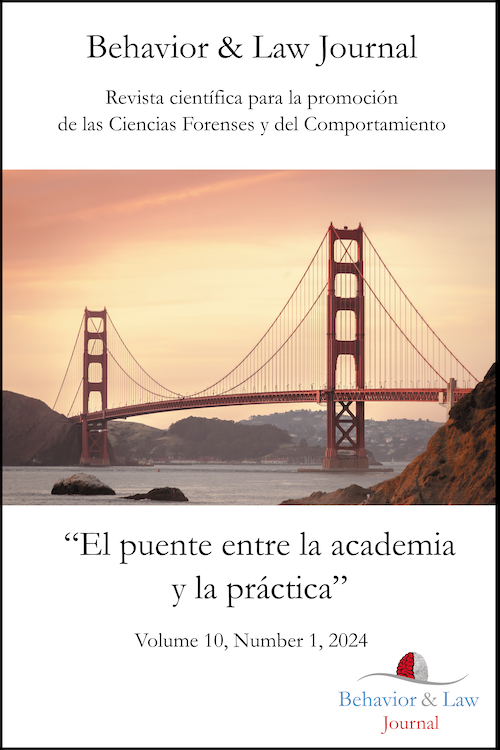Abstract
In the present study, an approach was carried out to characterize the psychological profile of a criminal profiler, also known as criminological profiler or criminal behavior analyst, for which eight (08) profilers of recognized professional trajectory were selected, both in the practical field and in academic training and practice. The selection was heterogeneous and random within a group of Spanish and Anglo speaking profilers. Several psychometric instruments were reviewed, of which the 16PF Questionnaire was considered because it offers a measurement of typical personality, which considers sixteen (16) personality factors and five (05) general dimensions (extroversion, anxiety, hardness, independence and self-control) within which the degree of boldness, security in social relations and entrepreneurial character of the individual is evaluated as opposed to shyness and social withdrawal, as well as the degree of suspicion and skepticism. Important coincidences were found in the factors of self-sufficiency, openness to change, independence and self-control. The results are discussed in the light of the ideal characteristics for the exercise of this professional practice with a view to future research.
References
Aluja, A. & Blanch, A. Replicabilidad de los factores de segundo orden del 16PF-5 en muestras americanas y españolas. Psicothema 15(2), 309-314. https://www.psicothema.com/pdf/1062.pdf
Boeree, G. (1998). Teorías de la personalidad. Universidad de Shippensburg.
Burgos, Á. (2010). La criminalística y su importancia en el campo forense. Revista Digital de Ciencias Penales de Costa Rica (2), 239-239.
Cattell, R., Russell, M., Karol, D., Cattell, A., & Cattell, H. (2011). 16PF-5, Cuestionario factorial de personalidad. TEA Ediciones, SA. https://revistas.ucr.ac.cr/index.php/RDMCP/article/view/12576
Consejo General de Psicólogos de España (2012). Evaluación del test 16-PF. 2 - 18 https://www.cop.es/uploads/PDF/16PF5.pdf
Díaz, G. (2020). Metodología del estudio piloto. Revista chilena de radiología, 26(3), 100-104. http://dx.doi.org/10.4067/S0717-93082020000300100
Turvey, B. (2010). “Forensic scientists”, in W. Petherick, B. Turvey y C. Ferguson (eds.), Forensic Criminology, Burlington, Elsevier Academic Press.
Turvey, B. (2012). A History of Criminal Profiling, in Criminal Profiling: an introduction to behavioral evidence analysis, 4th Edition, Elsevier Academic Press.
Jiménez, J., Turvey, B., Castelló, A., Strano M., Soto, J., Canter, D., Youngs D., González, J., & Sotoca, A. (2012). Manual práctico del perfil criminológico. 46-308 https://www.derechopenalenlared.com/libros/manual-practico-del-perfil-criminologico.pdf
Garrido, V. (2005). ¿Qué es la psicología criminológica? Biblioteca Nueva
Garrido, V. (2012). Perfiles criminales: un recorrido por el lado oscuro del ser humano. Barcelona: Ariel
Hernández, R., Fernández, C., & Baptista, P. (2018). Metodología de la investigación Vol.4 (pp. 310-386). McGraw-Hill.
Instituto Europeo de Ciencias Forenses y Seguridad (2018). Perfilación Criminal-Manual Forense. 15-16 https://ccytem.morelos.gob.mx/sites/ccytem.morelos.gob.mx/files/Perfilacion%20Criminal_%20Manual%20Fo%20-%20Instituto%20Europeo%20de%20Ciencias%20F.pdf
Norza E., Morales L., Merchán, L. & Meléndez, D. (2013). Perfilación criminológica: una revisión de la literatura y su aplicación en la investigación criminal en Colombia. Revista Criminalidad, 55 (3): 309-336 http://www.scielo.org.co/scielo.php?script=sci_arttext&pid=S1794-31082013000300008
Scherer, A. y Jarvis, P. (2014). Criminal Investigative Analysis: Practitioner Perspectives (Part One of Four). FBI Law Enforcement Bulletin. https://leb.fbi.gov/articles/featured-articles/criminal-investigative-analysis-practitioner-perspectives-part-one-of-four
Scherer, A. y Jarvis, P. (2014). Criminal Investigative Analysis: Skills Expertise and Training (Part Two of Four). FBI Law Enforcement Bulletin. https://leb.fbi.gov/articles/featured-articles/criminal-investigative-analysis-skills-expertise-and-training-part-two-of-four
Scherer, A. y Jarvis, P. (2014). Criminal Investigative Analysis: Measuring Success (Part Three of Four). FBI Law Enforcement Bulletin. https://leb.fbi.gov/articles/featured-articles/criminal-investigative-analysis-measuring-success-part-three-of-four
Scherer, A. y Jarvis, P. (2014). Criminal investigative analysis: Applications for the Courts (Part Four of Four. FBI Law Enforcement Bulletin. https://leb.fbi.gov/articles/featured-articles/criminal-investigative-analysis-applications-for-the-courts-part-four-of-four

This work is licensed under a Creative Commons Attribution-NonCommercial-NoDerivatives 4.0 International License.
Copyright (c) 2024 Behavior & Law Journal
